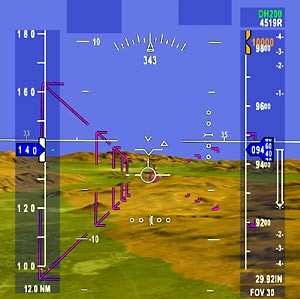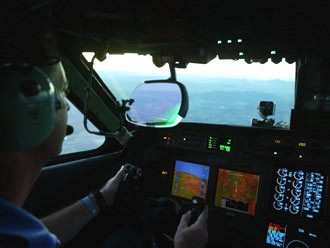No More Flying Blind
 Imagine seeing clear skies all the
time. It's not some weather fantasyland, but a revolutionary
cockpit display technology being developed by NASA to make flying
safer.
Imagine seeing clear skies all the
time. It's not some weather fantasyland, but a revolutionary
cockpit display technology being developed by NASA to make flying
safer.
Researchers for NASA's Aeronautics Research Mission Directorate
at Langley Research Center in Hampton (VA) tested the Synthetic
Vision Systems technology on a Gulfstream GV business jet in Nevada
and Virginia.
Seventeen pilots from government, the aerospace industry and
major airlines flew the GV over 67 hours in 22 flights to collect
data. They negotiated in and out of the Reno/Tahoe International
Airport and NASA's Wallops Flight Facility using the Synthetic
Vision System. A Gulfstream pilot was also in the cockpit as
pilot-in-command.
Synthetic Vision gives a pilot a clear electronic 3-dimensional
perspective of what's outside, no matter what the weather or time
of day. It combines Global Positioning System satellite signals
with an on-board photo-realistic database to paint a picture of
terrain for the crew.
In this flight test, NASA evaluated an integrated version of the
technology. It included a birds' eye view of topography, a
voice-recognition system, advanced sensors and equipment that
insures accuracy by using sensors to compare the real world to the
pictures being generated. Added to this was a Runway Incursion
Prevention System, which includes an airport moving map and
software that predicts possible encroaching runway traffic and
alerts the crew.
"NASA has already tested the individual technologies of
Synthetic Vision and Runway Incursion Prevention Systems on board a
NASA 757 aircraft," said Randy Bailey, Synthetic Vision principle
investigator. " We were particularly excited to be partnered with
Gulfstream which has been an industry innovator in aviation
technology."
During the flight evaluations, the test subject pilots flew at
night or with the windshield intentionally covered, simulating low
visibility conditions, so the pilot would have to rely on the
computer-generated information on the displays. Those displays
include head-down displays mounted into the plane's instrument
panel as well as a head-up display that superimposes terrain and
guidance information onto a screen located right in front of the
pilot's eyes.

A number of airline pilots have already flown components of the
Synthetic Vision System in simulators and a NASA 757 research jet.
"I think it's awesome." said United Airlines 767 Captain Rick Shay
of the technology. "To explain the difference in the situational
awareness that you gain, it's just a complete leap from the
technology that's there today."
NASA says it will use the results of the flight test to advance
Synthetic Vision Systems research, which is part of the NASA
Aviation Safety and Security Program's efforts to develop
technology to help reduce the fatal aircraft accident rate.
Synthetic Vision Systems could help eliminate the world's deadliest
aviation accidents, called Controlled Flight into Terrain (CFIT). A
CFIT accident is where a normally functioning aircraft slams into
the ground, water or an obstacle, either because the pilot wasn't
aware the plane was headed in the wrong direction, bad weather or a
combination of factors.
 ANN FAQ: Contributing To Aero-TV
ANN FAQ: Contributing To Aero-TV ANN's Daily Aero-Linx (05.29.24)
ANN's Daily Aero-Linx (05.29.24) ANN's Daily Aero-Term (05.29.24): NORDO (No Radio)
ANN's Daily Aero-Term (05.29.24): NORDO (No Radio) ANN's Daily Aero-Term (05.30.24): Beyond Visual Line Of Sight (BVLOS)
ANN's Daily Aero-Term (05.30.24): Beyond Visual Line Of Sight (BVLOS) ANN's Daily Aero-Linx (05.30.24)
ANN's Daily Aero-Linx (05.30.24)




